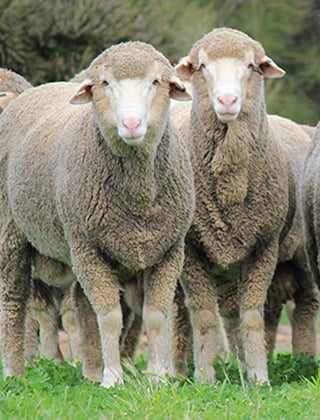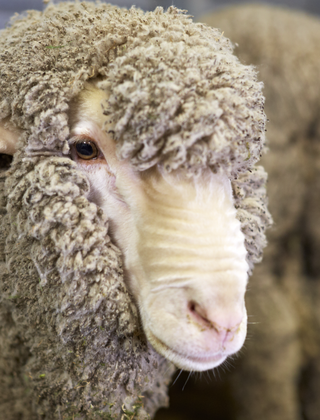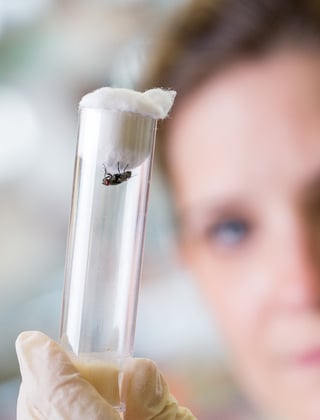New technology to measure wool follicle density

A new technology is being developed as part of an AWI- funded project that could enable woolgrowers to easily and cost effectively analyse the wool follicle density of sheep at a much younger age (prior to first shearing) than is currently possible. This would enable far more rapid genetic improvement in both wool production (weight) and quality (diameter).
Optical scan of a live sheep, showing wool follicles below the surface. Each wool follicle appears as a small, black dot and is approximately 20 microns in diameter. The image shows a 3mm x 3mm field of view.
A new technology is being developed as part of an AWI- funded project that could enable woolgrowers to easily and cost effectively analyse the wool follicle density of sheep at a much younger age (prior to first shearing) than is currently possible. This would enable far more rapid genetic improvement in both wool production (weight) and quality (diameter).
The wool-producing ‘factory’ of the sheep are the millions of follicles located just below the surface of the skin of the animal. In a Merino sheep, there are up to about 60 follicles in each square-millimetre.
Sheep with higher densities of wool follicles not only produce a heavier clean fleece weight, they also produce lower diameter fibres. Therefore, woolgrowers who select sheep with a greater density of wool follicles can improve both the quantity and quality of the wool in their flock. In addition, wool follicle density is highly heritable so genetic gains can readily be made.
At present, however, although wool follicle density can be measured using ‘histology’, few woolgrowers find this process to be either economically or logistically viable. Histology involves taking a small biopsy sample of the animal’s skin, chemically processing it and analysing it under a microscope. This process costs more than $100 per animal and can take several weeks.
MEASUREMENT AT YOUNGER AGE
A technology solution is currently being investigated in an AWI-funded project in collaboration with the University of Adelaide and Miniprobes Pty Ltd. The project brings together world-leading researchers in optical imaging, machine learning and livestock breeding and management.
Professor Wayne Pitchford of the School of Animal and Veterinary Sciences at the University of Adelaide says there is no product available on the market that can assess the potential wool production of a lamb prior to its first shearing.
“If woolgrowers were able to more readily and cost effectively identify high value sheep at an early stage (<8 months of age) they could significantly increase the rate of genetic improvement and profit in the flock. In parallel, by identifying sheep with low quality, coarse wool at a young age, woolgrowers could eliminate these sheep from the flock at an early stage,” Professor Pitchford said.
“Our primary target market is Australian Merino ram breeders. Stud breeders sell high value sheep to commercial woolgrowers, and maximising genetic improvement in their sheep is a critical product differentiator for the breeders.
“Consider the current selection situation. The gestation length for a sheep is approximately five months. Lambs are typically shorn for the first time at around one year of age. By assessing the fleece, it takes 17 months to select and produce one generation of sheep.”
“Using our technology to analyse the wool follicles in younger sheep, the farmer would be able to produce with greatly increased accuracy and speed a new generation of improved sheep.”
- Professor Wayne Pitchford
Although selection using follicle density could improve the accuracy of current fleece weight assessments alone, it could also reduce the generation interval when combined with other technologies, such as juvenile in vitro embryo transfer, with which it is possible to harvest eggs from sheep as early as two months of age.
“Using our technology to analyse the wool follicles in younger sheep, the farmer would be able to produce with greatly increased accuracy and speed a new generation of improved sheep.”
OPTICAL IMAGING TECHNOLOGY
The researchers have developed a high-resolution optical imaging technology, known as optical coherence tomography (OCT), that can be used to rapidly quantify the density of the follicles and the diameter of the wool fibre that will be produced. Pilot scans on live sheep have already been successfully performed that show a strong correlation between the results from the optical scan and histology.
OCT is a medical imaging technology that is commonly used in the ophthalmology and cardiology departments of many hospitals. The researchers have re-purposed this technology for use in sheep.
Dr Robert Mclaughlin of Miniprobes Pty Ltd says that while there are multiple manufacturers from whom off-the-shelf scanners can be sourced, the innovation in this AWI-funded project is in customising the scanners for use on-farm, and in the development of intelligent machine learning software to automatically measure the density and size of the wool follicles.
“With automated analysis software to measure the wool follicles, the entire process could be completed within a few minutes.”
- Dr Robert Mclaughlin
“We are developing a point-and-click scanner that uses optical imaging to look below the skin surface and analyse the wool follicles rapidly and safely,” Dr Mclaughlin said.
“Our technology does not use any chemicals and does not require that tissue be removed from the sheep. It only requires that a small area of the sheep have wool temporarily removed so that we can image the skin.
“With automated analysis software to measure the wool follicles, the entire process could be completed within a few minutes.”
At the end of the project, the researchers will provide a detailed product development and commercialisation plan for the device.















